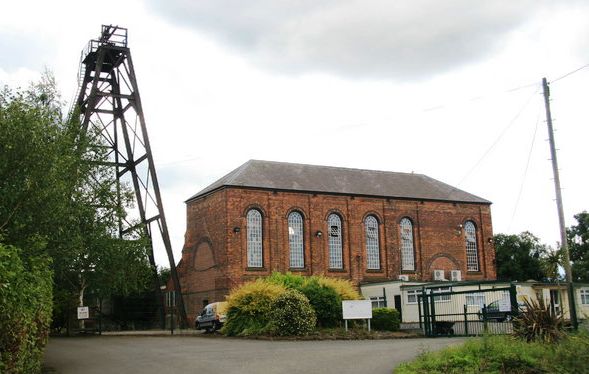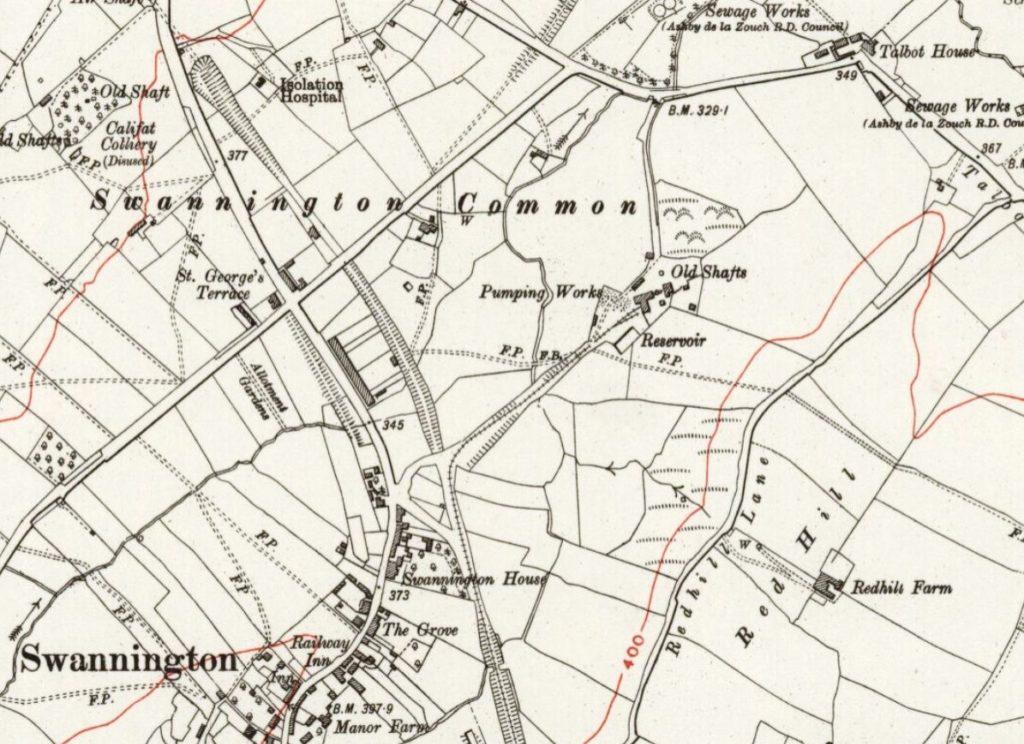The exposed coal measures in the Swannington and Coleorton districts were extensively worked from the beginning of the 13th century by opencast, bell pits, pillar and stall, and from an early date, by longwall face methods. The activities of these coal workings in the early part of the 19th century were a major factor in the promotion and building of the Leicester & Swannington Railway. A further impetus to coal working came in the mid-19th century by the opening of the Leicester to Burton line of the Midland Railway in 1848. This line incorporated much of the older Leicester & Swannington Railway.

Calcutta Colliery Pumping Engine House
Copyright © Chris Allen and licensed for reuse under this Creative Commons Licence
Major landowners and therefore holders of the mineral rights were the Beaumont Estate and the Trustees of Wyggeston Hospital (modern spelling Wigston) which was located in Leicester. A Benjamin Walker and a William Worswick negotiated leases of the coal under the two estates. William Worswick was the owner of extensive properties around Leicester and was also a coal merchant. The two associates having already worked coal in the area, sank a new and for the time, a large colliery at Coleorton which became generally known as California Colliery. This was in 1849 and in the early 1850’s two further collieries were commenced in Swannington, which were generally known as the Calcutta and Califat Collieries. The Calcutta shaft intersected the Main Seam at 474 feet from the surface and at Califat (SK 412171), the Main Seam was intersected at 385 feet. At Calcutta, the Main Seam was 7ft. 5ins. thick. Two further collieries, Sinope and Clink, were sunk in the early 1860’s. All of the collieries had closed by 1877 after quite short lives. Water held in old and uncharted workings was a major problem, and much pumping was required. A serious and fatal inundation took place at Califat Colliery in 1858. Also, coal had been previously worked out in places, again by old and uncharted workings.
A haystack boiler shell which had been used as a water tank on the Califat Colliery site was discovered and recovered in 1970. Subsequent investigations on the site revealed some foundations of what was very likely an inverted beam pumping engine. The haystack boiler was however, of a much earlier period than the pumping engine and would not have been used in a steam raising capacity for this engine. This boiler was related to the era of Newcomen-type atmospheric pumping engines.
The run-down of these collieries in Swannington and Coleorton with the loss of their pumping capacity posed a future problem with water at the Snibston and Whitwick collieries to the south. A joint pumping company was set up which would keep the old pumps running until a high capacity central pumping station could be established.
CALCUTTA COLLIERY (SK 420169) was chosen as the new pumping station and a (then) modern pumping engine was installed in 1877. The engine was a horizontal tandem compound having cylinders 42in.(HP), 72in.(LP) x 8ft. stroke. The high pressure cylinder was fitted with Meyer expansion slide valves and the low pressure cylinder had a plain slide valve. The three eccentrics, two for the HP slide valves and one for the LP slide valve were mounted on an outboard shaft driven by a drag link from the crankpin. Polished wood lagging covered the cylinders. The flywheel was 32 feet diameter and said to be 50 tons in weight.
The pumping shaft was outdoors of the engine house and was surmounted by two inverted-tee angle bobs or quadrants. The upstanding legs were coupled at the top. An extension from the LP cylinder piston tail rod was coupled to the top of the inner angle bob. Two bucket lift pumps 26in. x 8ft. stroke, were placed in the shaft at 90 yards from the surface, each quadrant operating one bucket pump. The engine ran at 8½ rpm and the theoretical discharge from both pumps together was 2990 gallons per minute. The two pump rods were each 12ins. square of pitch pine.
The whole assembly of engine and pump quadrants was approximately 125 feet in length.
To supply steam, five Cornish boilers, 5ft. dia. x 26ft. long were installed, the working pressure being 60psi.
The entire installation was made by Robert Stephenson & Co., Newcastle-upon-Tyne. The engine was maker’s number 328. The plant was in service until 1947, when it was replaced by electrically driven pumps.
The steam plant was not entirely without problems and there was a major breakdown in 1882. With the stoppage of pumping, the rising water in the exposed coal measures, over-topped the coal barrier left to protect the Snibston Colliery workings causing flooding at Snibston Colliery.
Copyright © NMRS Records: Geoff Hayes Collection

OS Map, Leicestershire XVI.SE 1920
The colliery is marked as “Pumping Works”
Reproduced by permission of the National Library of Scotland

